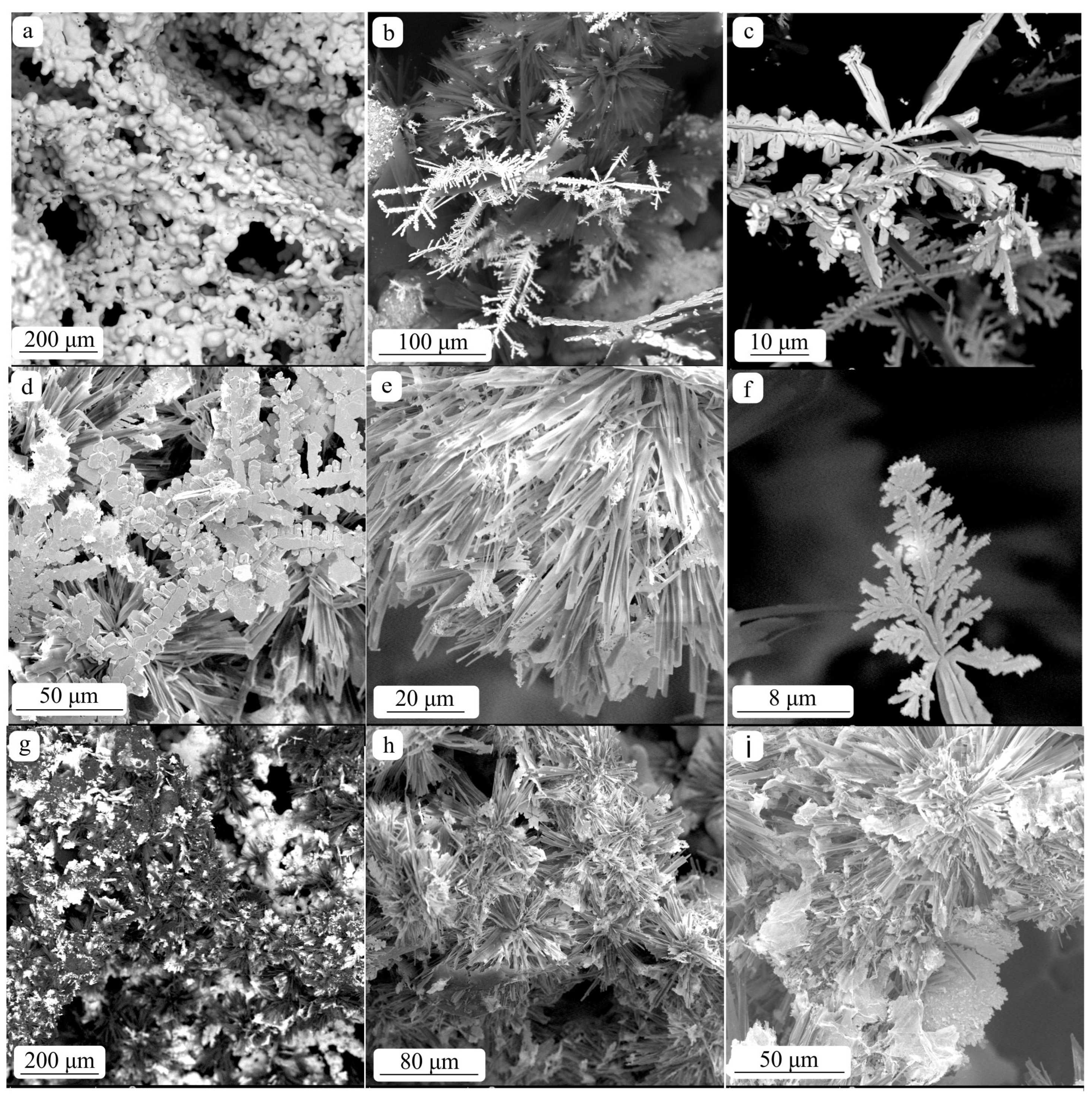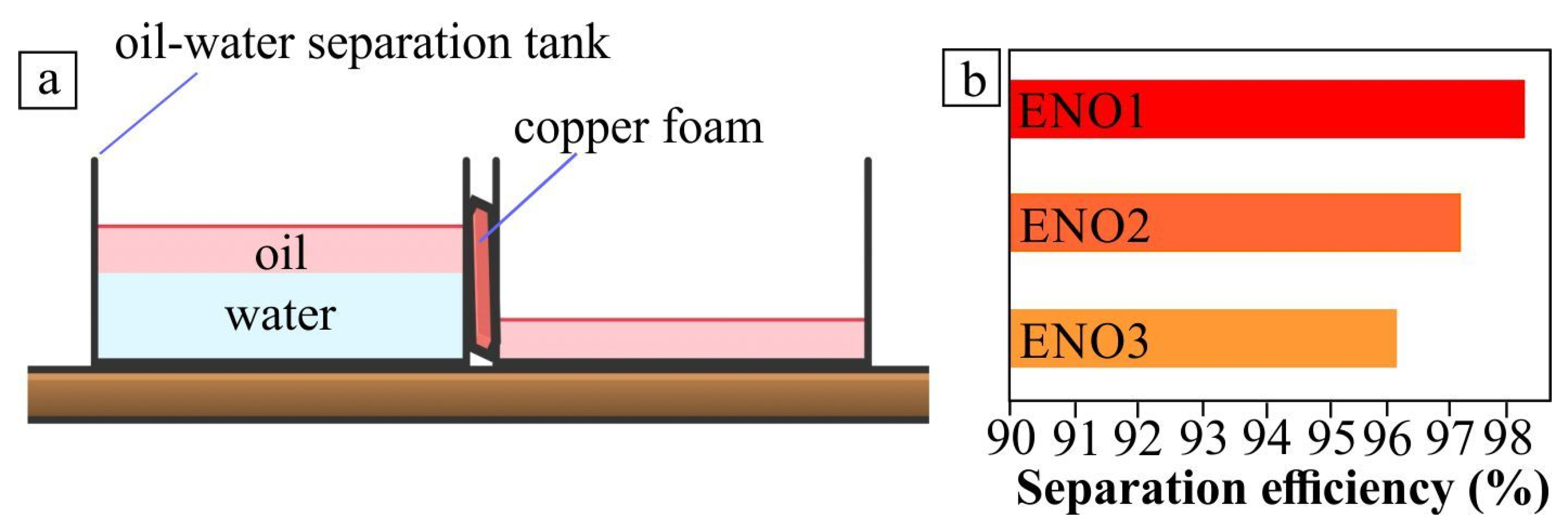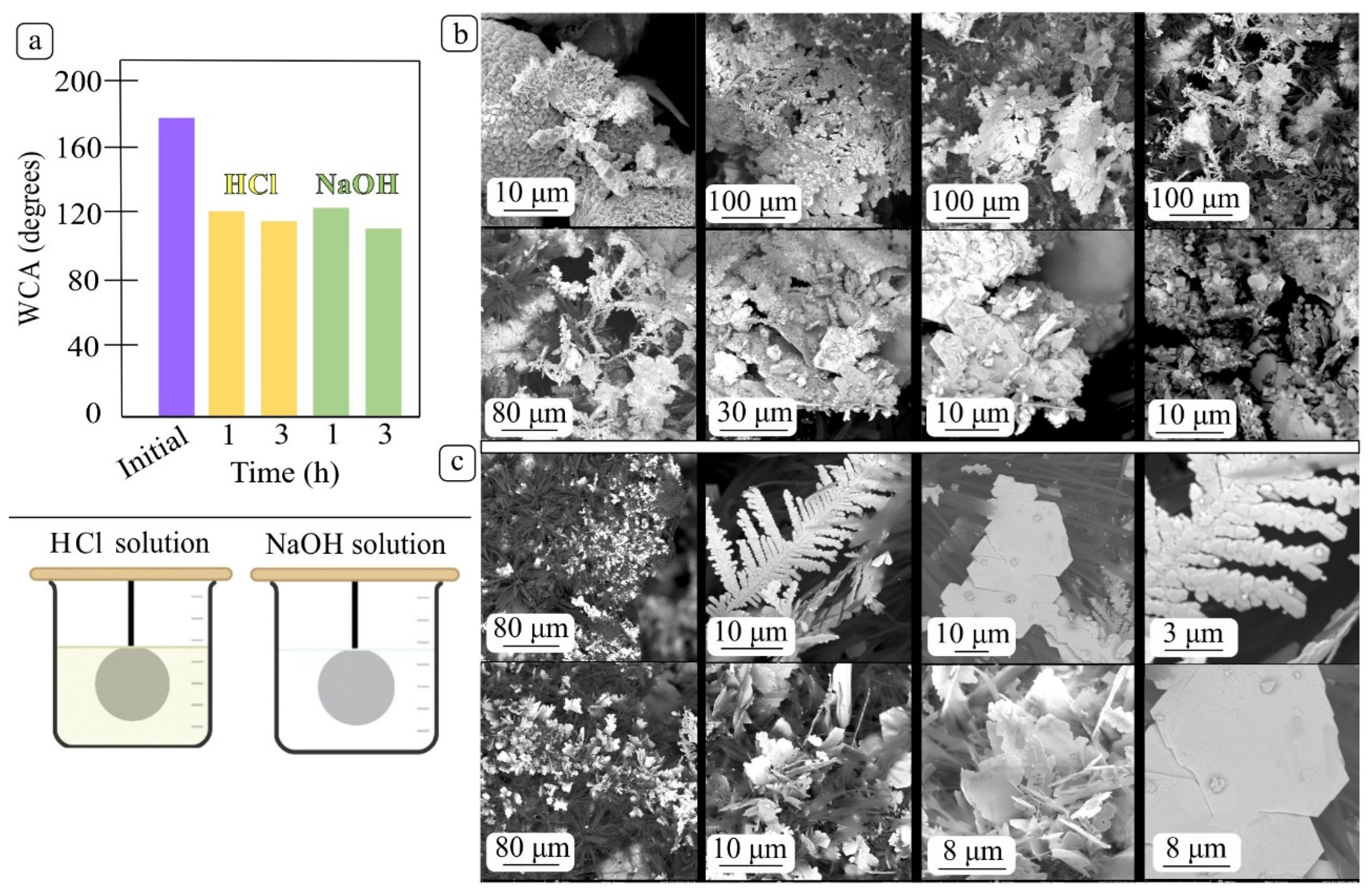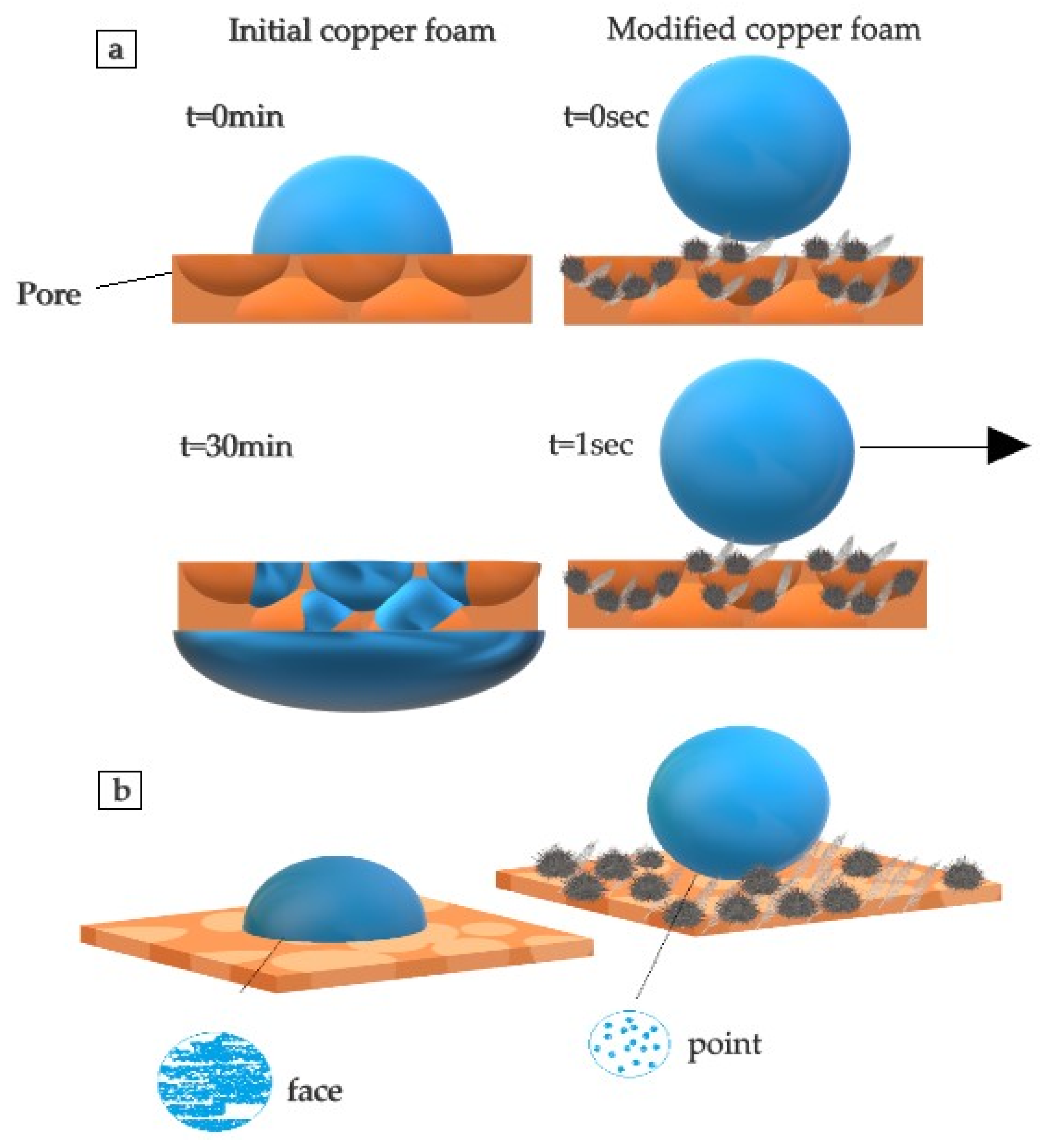Preparation and Characterization of Stable Superhydrophobic Copper Foams Suitable for Treatment of Oily Wastewater
Abstract
:1. Introduction
2. Materials and Methods
2.1. Materials
2.2. Preparation of Superhydrophobic Copper Foams
2.3. Characterization of Superhydrophobic Copper Foam
3. Results and Discussion
3.1. Effect of Immersion Time
3.2. Surface Wettability
3.3. Oil-Water Separation
3.4. Thermal and Chemical Stability
4. Discussion
5. Conclusions
Supplementary Materials
Author Contributions
Funding
Institutional Review Board Statement
Informed Consent Statement
Data Availability Statement
Conflicts of Interest
References
- Mu, L.; Yue, X.; Hao, B.; Wang, R.; Ma, P.C. Facile preparation of melamine foam with superhydrophobic performance and its system integration with prototype equipment for the clean-up of oil spills on water surface. Sci. Total Environ. 2022, 833, 155184. [Google Scholar] [CrossRef] [PubMed]
- Li, J.; Gao, R.; Wang, Y.; Zhang, T.C.; Yuan, S. Superhydrophobic palmitic acid modified Cu(OH)2/CuS nanocomposite-coated copper foam for efficient separation of oily wastewater. Colloids Surf. A Physicochem. Eng. Asp. 2022, 637, 128249. [Google Scholar] [CrossRef]
- An, K.; Zhang, X.; Qing, Y.; Long, C.; Sui, Y.; Yang, Z.; Wang, L.; Liu, C. One-step fabrication of robust superhydrophobic cerium-based nickel foam for oil-water separation and photocatalytic degradation. J. Taiwan Inst. Chem. Eng. 2021, 129, 246–255. [Google Scholar] [CrossRef]
- Shi, Y.; Zhong, Y.; Sun, Z.; Ma, X.; Li, S.; Wang, F.; An, Y.; Luo, Q.; Zhu, J.; Chen, J.; et al. One-step foam assisted synthesis of robust superhydrophobic lignin-based magnetic foams for highly efficient oil-water separation and rapid solar-driven heavy oil removal. J. Water Process Eng. 2022, 46, 102643. [Google Scholar] [CrossRef]
- Xue, Y.; Duan, S.; Du, T.; Hongkun, Y.C.; Li, M.; Chen, J. Facile synthesis of superwetting FeNi foam for oil/water separation. Colloids Surf. A Physicochem. Eng. Asp. 2022, 636, 128152. [Google Scholar] [CrossRef]
- Sui, W.; Hu, H.; Lin, Y.; Yi, P.; Miao, L.; Zhang, H.; He, H.; Li, G. Mussel-inspired pH-responsive copper foam with switchable wettability for bidirectional oil-water separation. Colloids Surf. A Physicochem. Eng. Asp. 2021, 630, 127603. [Google Scholar] [CrossRef]
- Chen, Z.; Zuo, J.; Zhao, T.; Tan, Q.; Nong, Y.; Xu, S.; Cheng, J.; Wen, X.; Pi, P. Superhydrophobic copper foam bed with extended permeation channels for water-in-oil emulsion separation with high efficiency and flux. J. Environ. Chem. Eng. 2023, 11, 109018. [Google Scholar] [CrossRef]
- Wang, Y.; Ou, B.; Zhu, P.; Niu, B.; Gu, Y.; Zhi, Q. High mechanical strength aluminum foam epoxy resin composite material with superhydrophobic, anticorrosive and wear-resistant surface. Surf. Interfaces 2022, 29, 101747. [Google Scholar] [CrossRef]
- Liu, H.; Zhai, W.; Park, C.B. Biomimetic hydrophobic plastic foams with aligned channels for rapid oil absorption. J. Hazard. Mater. 2022, 437, 129346. [Google Scholar] [CrossRef]
- Bharat, B. Bioinspired oil–water separation approaches for oil spill clean-up and water purification. Phil. Trans. R. Soc. A 2019, 377, 20190120. [Google Scholar] [CrossRef] [Green Version]
- Zhao, G.; Li, J.; Huang, Y.; Yang, L.; Ye, Y.; Walsh, F.C.; Chen, J.; Wang, S. Robust Ni/WC superhydrophobic surfaces by Electrodeposition. RSC Adv. 2017, 7, 44896–44903. [Google Scholar] [CrossRef]
- Luo, Z.-Y.; Chen, K.-X.; Wang, J.-H.; Mo, D.-C.; Lyu, S.-S. Hierarchical nanoparticle-induced superhydrophilic and under-water superoleophobic Cu foam with ultrahigh water permeability for effective oil/water separation. J. Mater. Chem. A 2016, 4, 10566–10574. [Google Scholar] [CrossRef]
- Wang, Z.; Yang, H.-C.; He, F.; Peng, S.; Li, Y.; Shao, L.; Darling, S.B. Mussel-Inspired Surface Engineering for Water-Remediation Materials. Matter 2019, 1, 115–155. [Google Scholar] [CrossRef]
- Zhang, Y.; Liu, J.; Quyang, L.; Li, J.; Xie, G.; Yan, Y.; Weng, C. One-Step Preparation of Robust Superhydrophobic Foam for Oil/Water Separation by Pulse Electrodeposition. Langmuir 2021, 37, 7043–7054. [Google Scholar] [CrossRef] [PubMed]
- Hu, Y.; Zhu, Y.; Wang, H.; Wang, C.; Li, H.; Zhang, X.; Yuan, R.; Zhao, Y. Facile preparation of superhydrophobic metal foam for durable and high efficient continuous oil-water separation. Chem. Eng. J. 2017, 322, 157–166. [Google Scholar] [CrossRef]
- Ji, K.; Liu, J.; Zhang, J.; Chen, J.; Dai, Z. Super-floatable multidimensional porous metal foam integrated with a bionic superhydrophobic surface. J. Mater. Chem. A 2014, 2, 16589–16593. [Google Scholar] [CrossRef]
- Zhang, Z.; Zhang, P.; Gao, Y.; Yun, J. Fabrication of superhydrophobic copper meshes via simply soaking for oil/water separation. Colloids Surf. A Physicochem. Eng. Asp. 2022, 642, 128648. [Google Scholar] [CrossRef]
- Xia, L.; Chen, F.; Cai, Z.; Chao, J.; Tian, Y.; Zhang, D. Magnet-Assisted Selective Oil Removal from Water in Non-Open Channel and Continuous Oil Spills Clean-Up. Sep. Purif. Technol. Part B 2022, 282, 120119. [Google Scholar] [CrossRef]
- Cao, Z.; Ouyang, Z.; Liu, Z.; Li, Y.; Ouyang, Y.; Lin, J.; Xie, X.; Long, J. Effects of surface oxides and nanostructures on the spontaneous wettability transition of laser-textured copper surfaces. Appl. Surf. Sci. 2021, 560, 150021. [Google Scholar] [CrossRef]
- Du, J.; Chen, L.; Zeng, X.; Yu, S.; Zhou, W.; Tan, L.; Dong, L.; Zhou, C.; Cheng, J. Hard-and-Soft Integration Strategy for Preparation of Exceptionally Stable Zr(Hf)-UiO-66 via Thiol–Ene Click Chemistry. ACS Appl. Mater. Interfaces 2020, 12, 28576–28585. [Google Scholar] [CrossRef]
- Caldona, E.B.; Brown, H.O.; Smith, D.W., Jr.; Wipf, D.O. Superhydrophobic/Superoleophilic Surfaces by Electroless Nanoparticle Deposition and Perfluorinated Polymer Modification. Ind. Eng. Chem. Res. 2021, 60, 14239–14250. [Google Scholar] [CrossRef]
- Caldona, E.B.; Sibaen, J.W.; Tactay, C.B.; Mendiola, S.L.D.; Abance, C.B.; Añes, M.P.; Serrano, F.D.; De Guzman, M.S. Preparation of spray-coated surfaces from green-formulated superhydrophobic coatings. SN Appl. Sci. 2019, 1, 1657. [Google Scholar] [CrossRef]
- Zhang, J.; Chen, R.; Liu, J.; Liu, Q.; Yu, J.; Zhang, H.; Jing, X.; Zhang, M.; Wang, J. Construction of ZnO@Co3O4-loaded nickel foam with abrasion resistance and chemical stability for oil/water separation. Surf. Coat. Technol. 2019, 357, 244–251. [Google Scholar] [CrossRef]
- Eum, K.Y.; Phiri, I.; Kim, J.W.; Choi, W.S.; Ko, J.; Myoun, K.; Jung, H. Superhydrophobic and superoleophilic nickel foam for oil/water separation. Korean J. Chem. Eng. 2019, 36, 1313–1320. [Google Scholar] [CrossRef]
- Álvarez-Gil, L.; Ramírez, J.; Fernández-Morales, P. Ultra-hydrophobic aluminum foam development for potential application in continuous water-oil separation processes. Surf. Interfaces 2021, 26, 101362. [Google Scholar] [CrossRef]
- Tang, F.; Wang, D.; Zhou, C.; Zeng, X.; Du, J.; Chen, L.; Zhou, W.; Lu, Z.; Tan, L.; Dong, L. Natural polyphenol chemistry inspired organic-inorganic composite coating decorated PVDF membrane for oil-in-water emulsions separation. Mater. Res. Bull. 2020, 132, 110995. [Google Scholar] [CrossRef]
- Zeng, X.; Cai, W.; Fu, S.; Lin, X.; Lu, Q.; Liao, S.; Hu, H.; Zhang, M.; Zhou, C.; Wen, X.; et al. A novel Janus sponge fabricated by a green strategy for simultaneous separation of oil/water emulsions and dye contaminants. J. Hazard. Mater. Part B 2022, 424, 127543. [Google Scholar] [CrossRef]
- Liu, Y.; Zhan, B.; Zhang, K.; Kaya, C.; Stegmaier, T.; Han, Z.; Ren, L. On-demand oil/water separation of 3D Fe foam by controllable wettability. Chem. Eng. J. 2018, 331, 278–289. [Google Scholar] [CrossRef]
- Zhang, K.; Lia, H.; Yina, X.; Wang, Z. Oil/water separation on structure-controllable Cu mesh: Transition of superhydrophilic-superoleophilic to superhydrophobic-superoleophilic without chemical modification. Surf. Coat. Technol. 2019, 358, 416–426. [Google Scholar] [CrossRef]
- Zhang, Y.-P.; Yang, J.-H.; Li, L.-L.; Cui, C.-X.; Li, Y.; Liu, S.-Q.; Zhou, X.-M.; Qu, L.-B. Facile Fabrication of Superhydrophobic Copper-Foam and Electrospinning Polystyrene Fiber for Combinational Oil–Water Separation. Polymers 2019, 11, 97. [Google Scholar] [CrossRef] [Green Version]
- Xu, M.; Chen, Y.-F.; Liang, J.-Y.; Mo, D.-C.; Lyu, S.-S. Electrodeposition Patterned Copper Foam with Micro/Nanostructures for Reducing Supercooling in Water-Based Cool Storage Phase-Change Materials. Appl. Sci. 2020, 10, 4202. [Google Scholar] [CrossRef]
- Rong, J.; Zhang, T.; Qiu, F.; Xu, J.; Zhu, Y.; Yang, D.; Dai, Y. Design and preparation of efficient, stable and superhydrophobic copper foam membrane for selective oil absorption and consecutive oil–water separation. Mater. Des. 2018, 142, 83–92. [Google Scholar] [CrossRef]
- Xu, J.; Jinliang, X.; Cao, Y.; Ji, X.; Yan, Y. Fabrication of non-flaking, superhydrophobic surfaces using a one-step solution-immersion process on copper foams. Appl. Surf. Sci. 2013, 286, 220–227. [Google Scholar] [CrossRef]
- Wang, Q.C.; Yang, X.D.; Shang, G.R. Fabrication of copper-based Superhydrophobic surface through template deposition. Adv. Mater. Res. 2014, 915–916, 799–802. [Google Scholar] [CrossRef]
- Bhagat, S.D.; Gupta, M.C. Superhydrophobic microtextured polycarbonate surfaces. Surf. Coat. Technol. 2015, 270, 117–122. [Google Scholar] [CrossRef]
- Shirazy, M.R.S.; Blais, S.; Fréchette, L.G. Mechanism of wettability transition in copper metal foams: From superhydrophilic to hydrophobic. Appl. Surf. Sci. 2012, 258, 6416–6424. [Google Scholar] [CrossRef]
- Asif, R.; Khan, H.N.; Jomiur, N.A.; Haq, M.U. To Determine the Concentration of Cobalt (II) In The Cobalt (II) Nitrate Hexahydarate Solution by UV-Visible Spectroscopy. J. Appl. Chem. 2019, 12, 22–27. [Google Scholar]
- Gu, Q.; Chen, Y.; Chen, D.; Zhang, Z. Construction of super-hydrophobic copper alloy surface by one-step mixed solution immersion method. IOP Conf. Ser. Earth Environ. Sci. 2018, 108, 022038. [Google Scholar] [CrossRef]
- Stergioudi, F.; Baxevani, A.; Mavropoulos, A.; Skordaris, G. Deposition of Super-Hydrophobic Silver Film on Copper Substrate and Evaluation of Its Corrosion Properties. Coatings 2021, 11, 1299. [Google Scholar] [CrossRef]
- Nakamura, T.; Magara, H.; Herbani, Y.; Sato, S. Fabrication of silver nanoparticles by highly intense laser irradiation of aqueous solution. Appl. Phys. A Mater. Sci. Process. 2011, 104, 1021–1024. [Google Scholar] [CrossRef]
- Rodríguez-León, E.; Iñiguez-Palomares, R.; Navarro, R.E.; Herrera-Urbina, R.; Tánori, J.; Iñiguez-Palomares, C.; Maldonado, A. Synthesis of silver nanoparticles using reducing agents obtained from natural sources (Rumex hymenosepalus extracts). Nanoscale Res. Lett. 2013, 8, 318. [Google Scholar] [CrossRef] [PubMed] [Green Version]
- Li, H.; Lu, Y.; Zou, X.; Wang, C.; Wei, H. One Step Preparation of Superhydrophobic Surface on Copper Substrate with Anti-Corrosion and Anti-Icing Performance. Int. J. Electrochem. Sci. 2020, 15, 10674–10683. [Google Scholar] [CrossRef]
- Bakirdere, S.; Yilmaz, M.T.; Tornuk, F.; Keyf, S.; Yilmaz, A.; Sagdic, O.; Kocabas, B. Molecular characterization of silver-stearate nanoparticles (AgStNPs): A hydrophobic and antimicrobial material against foodborne pathogens. Food Res. Int. 2015, 76, 439–448. [Google Scholar] [CrossRef] [PubMed]
- Hu, Z.-S.; Hsu, S.M.; Wang, P.S. Tribochemical and thermochemical reactions of stearic acid on copper surfaces studied by infrared microspectroscopy. Tribol. Trans. 1992, 35, 189–193. [Google Scholar] [CrossRef]
- Dong, J.; McCormick, A.V.; Davis, H.T.; Whitcomb, D.R. Cation-Controlled Crystal Growth of Silver Stearate: Cryo-TEM Investigation of Lithium vs. Sodium Stearate. Langmuir 2010, 26, 2263–2267. [Google Scholar] [CrossRef]
- Qu, L.; Dai, L. Novel silver nanostructures from silver mirror reaction on reactive substrates. J. Phys. Chem. B 2005, 109, 13985–13990. [Google Scholar] [CrossRef]
- Che, P.; Liu, W.; Chang, X.; Wang, A.; Han, Y. Multifunctional silver film with superhydrophobic and antibacterial properties. Nano Res. 2016, 9, 442–450. [Google Scholar] [CrossRef]
- Mdluli, S.; Revaprasadu, N. Time dependant evolution of silver nanodendrites. Mater. Lett. 2009, 63, 447–450. [Google Scholar] [CrossRef]
- Li, H.; Sun, Y.; Wang, Z.; Wang, S. Constructing Superhydrophobic Surface on Copper Substrate with Dealloying-Forming and Solution-Immersion Method. Materials 2022, 15, 4816. [Google Scholar] [CrossRef]
- Sui, S.; Quan, H.; Hu, Y.; Hou, M.; Guo, S. A strategy of heterogeneous polyurethane-based sponge for water purification: Combination of superhydrophobicity and photocatalysis to conduct oil/water separation and dyes degradation. J. Colloid Interface Sci. 2021, 589, 275–285. [Google Scholar] [CrossRef]
- Wang, Y.; Zhao, S.; Guo, Z.; Huang, J.; Liu, W. Multi-layer superhydrophobic nickel foam (NF) composite for highly efficient water-in-oil emulsion separation. Colloids Surf. A Physicochem. Eng. Asp. 2021, 628, 127299. [Google Scholar] [CrossRef]
- Nosonovsky, M.; Bhushan, B. Roughness optimization for biomimetic superhydrophobic surfaces. Microsyst. Technol. 2005, 11, 535–549. [Google Scholar] [CrossRef]
- Wang, S.; Jiang, L. Definition of superhydrophobic states. Adv. Mater. 2007, 19, 3423–3424. [Google Scholar] [CrossRef]










Disclaimer/Publisher’s Note: The statements, opinions and data contained in all publications are solely those of the individual author(s) and contributor(s) and not of MDPI and/or the editor(s). MDPI and/or the editor(s) disclaim responsibility for any injury to people or property resulting from any ideas, methods, instructions or products referred to in the content. |
© 2023 by the authors. Licensee MDPI, Basel, Switzerland. This article is an open access article distributed under the terms and conditions of the Creative Commons Attribution (CC BY) license (https://creativecommons.org/licenses/by/4.0/).
Share and Cite
Baxevani, A.; Stergioudi, F.; Patsatzis, N.; Malletzidou, L.; Vourlias, G.; Skolianos, S. Preparation and Characterization of Stable Superhydrophobic Copper Foams Suitable for Treatment of Oily Wastewater. Coatings 2023, 13, 355. https://doi.org/10.3390/coatings13020355
Baxevani A, Stergioudi F, Patsatzis N, Malletzidou L, Vourlias G, Skolianos S. Preparation and Characterization of Stable Superhydrophobic Copper Foams Suitable for Treatment of Oily Wastewater. Coatings. 2023; 13(2):355. https://doi.org/10.3390/coatings13020355
Chicago/Turabian StyleBaxevani, Aikaterini, Fani Stergioudi, Nikolaos Patsatzis, Lamprini Malletzidou, George Vourlias, and Stefanos Skolianos. 2023. "Preparation and Characterization of Stable Superhydrophobic Copper Foams Suitable for Treatment of Oily Wastewater" Coatings 13, no. 2: 355. https://doi.org/10.3390/coatings13020355





